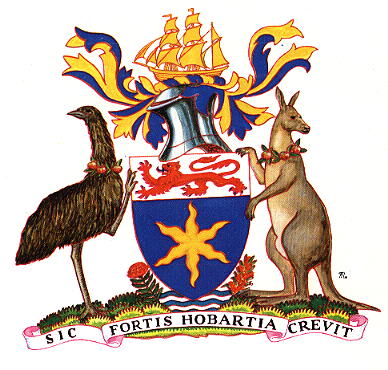Hobart: Difference between revisions
Knorrepoes (talk | contribs) No edit summary |
(No difference)
|
Revision as of 16:11, 25 October 2014
| Heraldry of the World Civic heraldry of Australia |
HOBART
State : Tasmania
Official blazon
Origin/meaning
The arms were granted in May 1953.
On the shield the red lion comes from Tasmania's flag badge, and also the crest of the State Arms. The estoile recalls the arms of Captain James Cook, first European to reach the eastern coast of Australia, although Abel Tasman, a Dutchman, was the first to land in Tasmania.
The supporters are the same as those in the National Arms, although here they have changed sides, and are each looking over their shoulder. The chaplets of apples round their necks refer to the state's nickname 'the Apple Isle', as so many are grown in the Hobart district.
The ship on the crest is the Flying Childers, built in Hobart by John Watson in 1847. It was used as a whaling ship, then in coastal trading, and finally trading overseas until its loss in 1870. It represents the importance of shipping to Hobart's growth. The waratah in the compartment is the species found in Tasmania, and is smaller than those on the mainland.
The motto is derived from a line in Virgil's Georgics (second book, line 533). Where he describes a prosperous rural community: "Sic fortis Etruria crevit" (Thus mighty Etruria grew).
Contact and Support
Partners:
Your logo here ?
Contact us
© since 1995, Heraldry of the World, Ralf Hartemink 
Index of the site
Literature : Low, 1971, and Denis Towner (dtowner@midcoast.com.au)










